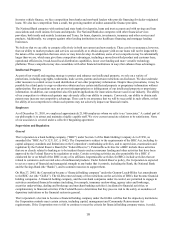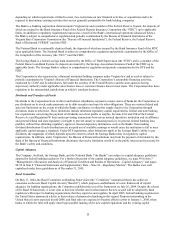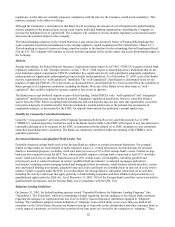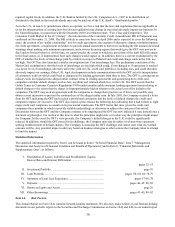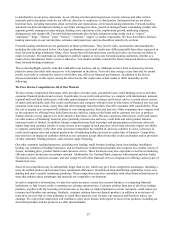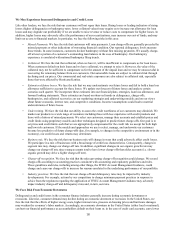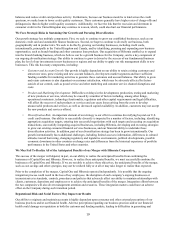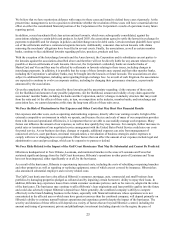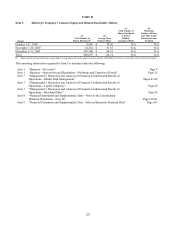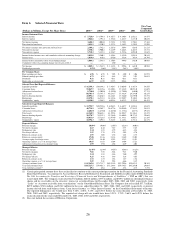Capital One 2005 Annual Report Download - page 25
Download and view the complete annual report
Please find page 25 of the 2005 Capital One annual report below. You can navigate through the pages in the report by either clicking on the pages listed below, or by using the keyword search tool below to find specific information within the annual report.required capital levels. In addition, the U.K. Bank is limited by the U.K. Companies Act—1985 in its distribution of
ividends to the Bank in that such dividends may only be paid out of the U.K. Bank’ s “distributable profits.” d
As in the U.S., in non-U.S. jurisdictions where we operate, we face a risk that the laws and regulations that are applicable to
us (or the interpretations of existing laws by relevant regulators) may change in ways that adversely impact our business. In
the United Kingdom, in connection with the December 2003 Government report, “Fair, Clear and Competitive: The
Consumer Credit Market in the 21st Century”, the introduction of the Consumer Credit (Amendment) Bill in Parliament was
confirmed on November 23, 2004. The Bill is likely to come into force in April 2006 and is expected to cover the following
areas: the creation of an “unfair relationship” test for credit agreements, the creation of alternative dispute resolution options
for credit agreements, a requirement on lenders to provide annual statements to borrowers outlining the full amount owed and
warnings about making only minimum repayments, and a stricter licensing regime that would give the OFT new powers to
fine lenders for their behavior. At this time, we cannot predict the extent to which the provisions of the draft bill will remain
in the final statute, or, if implemented, how such changes would impact us. In addition, there is a current examination by the
OFT of whether the levels of interchange paid by retailers in respect of MasterCard credit and charge cards in the U.K. are
too high. The OFT has also launched a similar investigation into Visa interchange fees. The preliminary conclusion of the
MasterCard examination is that the levels of interchange are too high which could, if not changed or if agreement is reached
on a lower level of interchange, adversely affect the yield on U.K. credit card portfolios, including ours, and could therefore
adversely impact our earnings. Other U.K. legal developments include communications with the OFT as to its interpretation
of consumer credit law which could lead to changes in the lending agreements from time to time. The OFT is carrying out an
industry wide investigation into alleged unfair contract terms in lending agreements and questioning how credit card
companies calculate default charges, such as late, overlimit and returned check fees, in the U.K. The OFT asserts that the
Unfair Terms in Consumer Contracts Regulations 1999 render unenforceable consumer lending agreement terms relating to
default charges to the extent that the charge is disproportionately high in relation to the actual cost of the default to the
companies. The OFT may seek an agreement with the companies to change their practices or, if this is not possible, may
obtain a court injunction to prevent the continued use of the alleged unfair term. In July 2005, the Company received a letter
from the OFT indicating the OFT had reached a provisional conclusion that the levels of default charges the credit card
companies impose are excessive. The OFT also issued a press release the following day indicating that it had written to eight
major credit card companies to consult on its provisional conclusion. The OFT had at that time, given the credit card
companies three months in which to provide suitable undertakings or otherwise to address the concerns it has raised.
Discussions between the OFT and the Company continue to be ongoing and the OFT has now indicated it may instead issue a
statement of principles; it is unclear at this time in what the principles might state or in what way the principles might impact
the Company. In the event the OFT’ s view prevails, the Company’ s default charges in the U.K. could be significantly
reduced. In addition, should the OFT prevail in its challenge, the Company may also be subject to claims from customers
seeking reimbursement of default charges. The Company is assessing the OFT challenge and cannot state what its eventual
outcome will be. Any potential impact could vary based on business strategies or other actions the Company takes to attempt
limit the impact.
to
S
tatistical Information
The statistical information required by Item 1 can be found in Item 6 “Selected Financial Data”, Item 7 “Management
Discussion and Analysis of Financial Condition and Results of Operations” and in Item 8, “Financial Statements and
Supplementary Data”, as follows:
I. Distribution of Assets, Liabilities and Stockholders’ Equity;
Interest Rates and Interest Differential .............................................
pages 52–53
II. Investment Portfolio ......................................................................... page 76
III. Loan Portfolio................................................................................... pages 50–60; 68; 78-79
IV. Summary of Loan Loss Experience.................................................. pages 57-60; 78
V. Deposits............................................................................................ pages 44–45; 80; 82
VI. Return on Equity and Assets ............................................................ page 26
VII. Other Borrowings ............................................................................. pages 43–45; 80–82
I em 1A. Risk Factors. t
This Annual Report on Form 10-K contains forward-looking statements. We also may make written or oral forward-looking
statements in our periodic reports to the Securities and Exchange Commission on Forms 10-Q and 8-K, in our annual report
16






